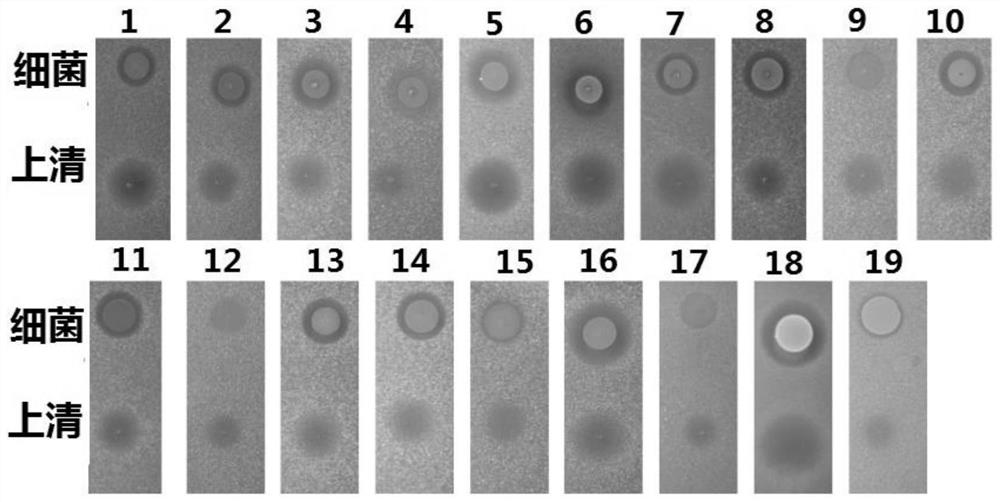A strain of human staphylococcus with broad-spectrum antibacterial activity against Gram-positive drug-resistant bacteria and its screening method and application
A Staphylococcus, Gram-positive technology, applied in the field of human Staphylococcus and its screening, can solve the unreported problems of the correlation between Staphylococcus and anti-Gram-positive drug-resistant bacteria, and achieve drug resistance, new structure, highly targeted effects
- Summary
- Abstract
- Description
- Claims
- Application Information
AI Technical Summary
Problems solved by technology
Method used
Image
Examples
Embodiment 1
[0029] This embodiment is a screening step for human staphylococcus with broad-spectrum antibacterial activity to Gram-positive drug-resistant bacteria, which includes:
[0030] Step 1) Perform routine flora culture on the skin swab samples of 200 males and 200 females aged 18-25 years old with normal physical examinations, no previous disease history, and no hospital contact history in the past six months in Shanghai, and 20 monoclonal samples for each sample Identification by MALDI-TOF MS and 16S rRNA gene sequencing. The results of the analysis found that Staphylococcus accounted for 80.2% of the skin cultureable flora of healthy people at the genus level. Further identification of Staphylococcus species was carried out, and it was found that Staphylococcus hominis accounted for 46.4%.
[0031] Step 2) Analyze the pathogenic methicillin-resistant Staphylococcus aureus (MRSA) and macrocyclic endogenous staphylococcus isolated from the skin surface of healthy people by plate...
Embodiment 2
[0037] In this example, the gene sequencing of Staphylococcus hominis S34-1, a molecule with broad-spectrum antibacterial activity among clinical Gram-positive drug-resistant pathogens screened in Example 1, was carried out. The result is as follows:
[0038] In this embodiment, the human staphylococcus strain S34-1, which produces molecules with broad-spectrum antibacterial activity against clinical Gram-positive drug-resistant pathogens, is subjected to whole-genome sequencing analysis ( figure 2 A), found that its size is 2195430bp, G+C content is 50%, contains 7 Prophage (prophage), 3 GI-like region (genome island), 2 plasmids, the size is 29577bp and 29535bp respectively ( figure 2 B).
[0039] The human staphylococcus strain S34-1 described in this example has been preserved on April 3, 2018, and its classification is named Staphylococcus hominis (Staphylococcus hominis), and its preservation number is CGMCC No.15552, and the preservation unit is China Microbiology G...
Embodiment 3
[0041] This embodiment is the antibacterial experiment verification of human staphylococcus bacterial strain S34-1, and it takes Staphylococcus aureus USA300 as an example, and the verification steps are as follows:
[0042] (1) Pick a single clone of Staphylococcus aureus USA300 and inoculate 10 ml of fresh TSB, shake the bacteria overnight at 37°C and 220 rpm.
[0043] (2) Detection of bacterial OD with a microplate reader 600 , to adjust the bacterial OD 600 Inoculate to 0.0001 into 50ml solid TSB medium, mix well and spread the plate.
[0044] (3) Pick a single clone of the S34-1 strain isolated from healthy human skin and inoculate it into 10 ml of fresh TSB, shake the bacteria overnight at 37° C. and 220 rpm.
[0045] (4) Take 5 μl of the bacterial suspension, the centrifuged supernatant and the precipitate of the bacterial culture and inoculate them on a solid plate containing USA300 bacteria. After drying, place them in a 37°C incubator for overnight cultivation, and...
PUM
 Login to View More
Login to View More Abstract
Description
Claims
Application Information
 Login to View More
Login to View More - R&D
- Intellectual Property
- Life Sciences
- Materials
- Tech Scout
- Unparalleled Data Quality
- Higher Quality Content
- 60% Fewer Hallucinations
Browse by: Latest US Patents, China's latest patents, Technical Efficacy Thesaurus, Application Domain, Technology Topic, Popular Technical Reports.
© 2025 PatSnap. All rights reserved.Legal|Privacy policy|Modern Slavery Act Transparency Statement|Sitemap|About US| Contact US: help@patsnap.com


